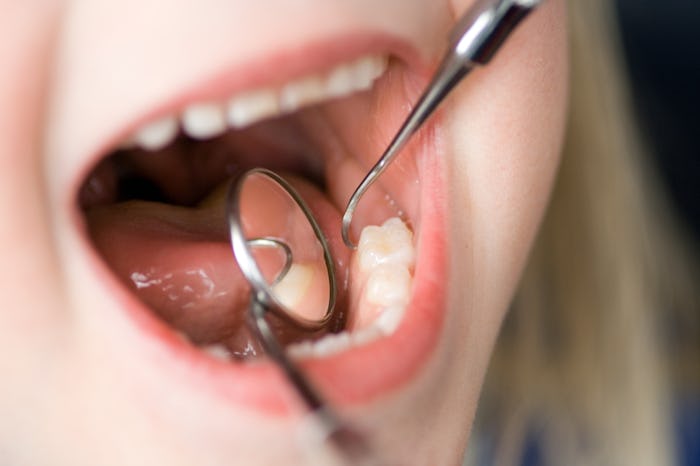Life
Even Though Your Kid Worked Hard To Grow Those Molars, They Won't Stick Around
It takes about two years for a baby to finish cutting their entire first set of teeth, but it can feel a few decades longer than that if teething turns your little one into a drooling, miserable mess. Molars are typically the last teeth to come in, and can be the most painful of all. If you’ve ever found yourself wondering if kids lose molars (because growing them seemed to be quite a traumatic experience) brace yourself: they’ll have to go through that ordeal once again when the first ones fall out and the permanent ones come in.
Teething typically starts around 4 months old, according to the Children’s Hospital of Wisconsin. The two front teeth on the bottom, called central incisors, usually arrive first. They’re followed by the four front incisors on top. Then come the first wave of molars, which show up around a year and a half. After that, expect to see the lateral cuspids and the cuspids (the pointy teeth you might have heard called the canines). The rest of the molars come in around 2 years old.
Though it only takes about two years for that first set of 20 teeth to come in, it takes much longer than that for them to fall out. According to Stanford Children’s Hospital, your kiddo will probably begin losing their baby teeth (and expecting some cash from the tooth fairy) around six years old. That process will likely continue until around 12. The second time around, the total number of teeth increases to 32.
Even though that first set of teeth is replaceable, it’s important to take good care of them. According to the Mayo Clinic, the permanent set of teeth are more likely come in crooked if the first set is damaged by trauma or tooth decay.
If your child's molars haven't come out on their own by the time they're ready for braces, your dentist might recommend pulling them. According to Identity Ortho, there are pros and cons to having molars removed once your child is old enough. Leaving them in could lead to problems if the permanent teeth come in anyway and cause overcrowding. Pulling them too soon, however, could cause new teeth to drift into the extra space and become crooked. The website suggested consulting an experienced orthodontist before making any decision about when to pull teeth.
Whatever you do, don't take matters into your own hands. Pulling a tooth on your own at home is frowned upon, according to Baby Center. It's totally fine for your child to wiggle and work at a loose tooth on their own, but you never want to start poking around in their mouth and accidentally hurt them.
Cutting teeth is unpleasant no matter how old you are, so don't forget that you might need a pain management plan when your child's permanent teeth start coming in. According to Colgate, school age kids who are getting their molars can experience headaches and sore gums, but luckily, the same teething remedies you probably used when they were a baby will work for an older kid. According to Parents, things like a massage, something cold to suck on, and pain relievers like Tylenol can be a huge help. And don't forget: teething woes may be a massive pain, but your kiddo's dazzling smile will make it all worth it in the end.
